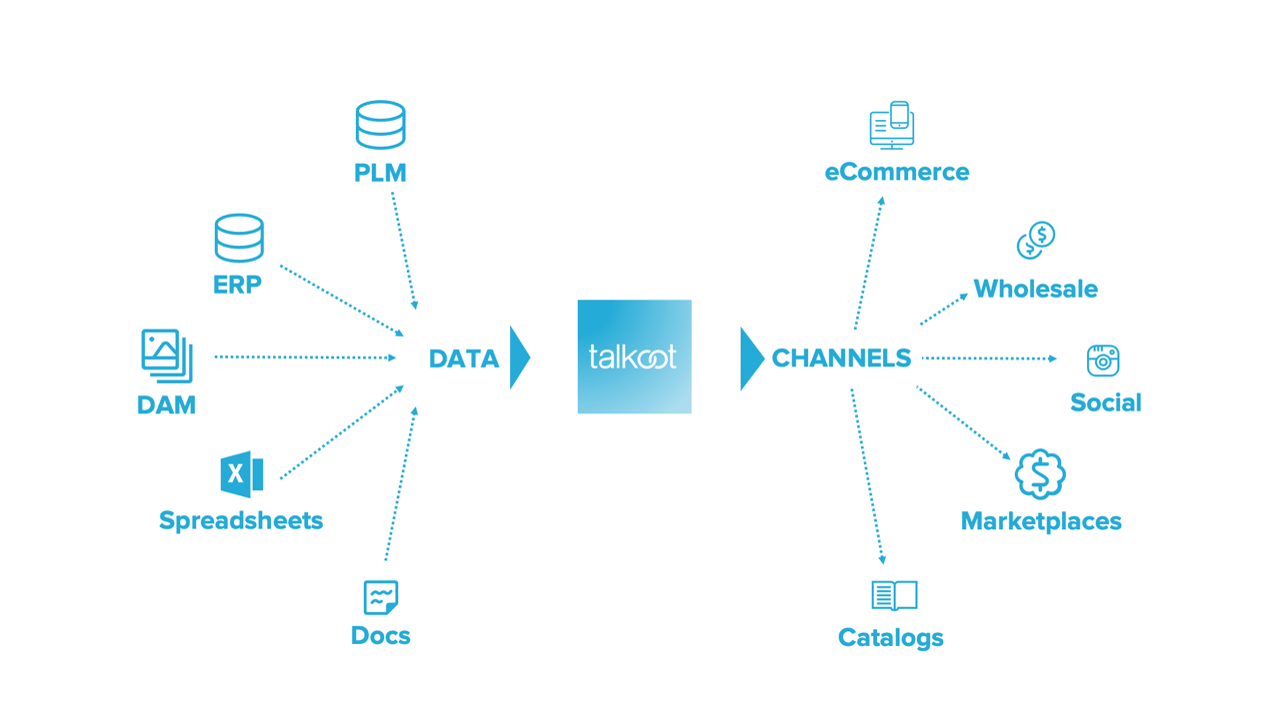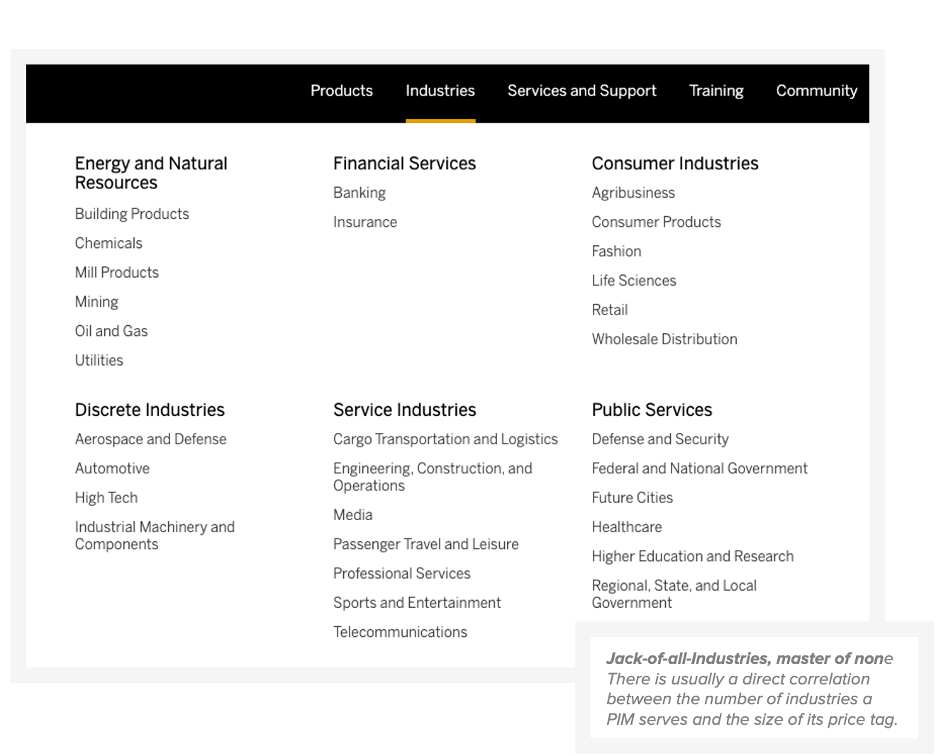What is a PIM 2021?

Brian Hennessy
Talkoot CEO and Co-Founder
Since we’ve all just lived through the greatest surge in online buying the world has ever seen, it’s probably a good time to refresh everyone’s understanding of what a Product Information Management (PIM) system is. Now that more shoppers are online than ever, more companies need a PIM than ever. And, due to competition and lower cloud computing costs, more companies can afford a PIM than ever before.
The 30,000 foot view
In its broadest sense, PIM software acts as a repository for all the customer-facing information a company needs to bring its products to market across all the channels it sells through.

A PIM should be easy to populate with content and data via file upload, data entry or integration with other information systems. It should also be easy to sort, filter and organize multiple versions of your product information within the system. Finally, a PIM should speed the transfer of information everywhere it needs to go, from your ecommerce platform and catalog management system to 3rd party marketplaces.
That definition is a good place to start. But it’s 2021 and a PIM is no longer just one thing. In fact, as my co-founder Derwyn Harris has said, it’s better to think about product information management as a challenge to solve rather than a system to buy. When you understand what problem you’re trying to solve, the type(s) of PIM you need will become clear.
Legacy PIMs
Many of the legacy PIMs on the market were first developed in the days before digital commerce. They were built for the needs of market sectors where the accuracy of product data was — and still is — paramount. Think: food and beverage with its stringent labeling requirements (size, weight, ingredient lists and nutrition information). Or pharmaceuticals and supplements. In these CPG categories, product information is highly regulated. If a manufacturer gets a detail wrong on a drug label it’s likely to face steep fines.
For companies like this, product content tends to be very information-based and static through time and across channels. Ingredients, weights and nutrition information tends to change infrequently. And there is no real need for product storytelling. No one needs to know the inspiration behind a can of corn or what it’s used for before they put it in their cart.
Because these legacy PIMs are built for the needs of F&B, pharma and similar industries, you’ll find they’re usually:
- large, enterprise-wide systems that can be relatively costly and slow to deploy
- not built for humans, meaning they often lack productivity, collaboration and workflow features
- Rigid, back office databases designed for storage, organization and syndication of large volumes of highly-structured product data
What PIMs were: everything-to-everybody
As more companies in more industries needed a PIM, these legacy systems began adding features to expand their market.
Today, most legacy PIMs have become everything-to-everybody platforms with a bloated feature set designed to meet the needs of every business — from industrial wholesalers to big box retailers to Aerospace. And though your company may never use the majority of these features, you’ll still see them reflected in the sticker price.

Where PIMs are headed
Though the PIM market has evolved more slowly, it’s still headed in the same direction as the rest of enterprise software: smaller, task-focused, less expensive, integrated and agile.
The future is specialized
With the meteoric rise of ecommerce, there has been a corresponding rise in the number of specialized systems that solve specific product information problems across the entire product information supply chain.
If you’re a retailer, you might have challenges aggregating and synthesizing content from all your vendors. There are solutions that do just that.
If you’re a small manufacturer selling across hundreds of marketplaces and big box retailers, you might face challenges syndicating your product information everywhere you sell. There are great systems for that.
And if you’re a brand trying to establish a strong, direct to consumer channel, you need a system that not only organizes all your product information, but helps your team turn it into the kind of powerful product stories that drive DTC success. That system is Talkoot.
You might have one of these problems. You might have all three. What you’ll find is, even if you have all three challenges, it’s likely more cost effective to implement three specialized systems that solve those three specific problems well instead of implementing a single, overbuilt, legacy PIM that will cost more, be slower to implement and leave all your teams frustrated and inefficient.
The future is small
The case against specialization has always been that specialized tools create information silos that lead to errors and inconsistency. Wisdom had it that everyone should be working in one system, even if it left teams frustrated and inefficient. By that same wisdom, working from a shared set of facts across all departments was worth more than the efficiency gained when each team worked in their own system of choice.
But look at any digital-native company taking their market by storm today and you’ll see a consistent theme: These companies skip the enterprise-wide solutions. Teams use whatever tools make them most efficient. And they avoid the data silos by wiring those tools together through integrations.
The future is integrated
Today most modern B2B systems are built to talk to each other. Data flows from one system to the other in real time through pre-built connectors or open APIs. Each team works efficiently in a tool purposely built for their needs without creating data silos that introduce errors and inconsistency.
The future is agile
When teams are working in specialized PIM applications built to solve their unique needs, they’re far more productive and efficient. They’re also just plain happier and more empowered — something that should never be overlooked. These specialized systems, along with the agile methodologies they enable, are how digital native startups are able to outmaneuver brands 10x their size.
Talkoot: The best PIM for direct to consumer brands
Talkoot is part of the latest wave of specialized Product Information Management Software. Talkoot is a PIM originally built to solve the product content challenges of apparel and footwear brands trying to establish a strong direct to consumer channel.
Talkoot features all the core information management functionality of any enterprise PIM. But where it really shines is as a collaborative productivity tool designed to help teams turn raw, unstructured product data, sketches, decks and briefs into higher-converting product stories.
It’s quick and less costly to deploy than a legacy PIM. And it’s scalable from department- to enterprise-level. Talkoot helps many of the world’s most loved brands drive billions of dollars of revenue across all their digital channels through more powerful product storytelling at scale.
Information confirms. Story connects and converts.
If you’re a fast-growing modern brand, it’s important to remember that no consumer brand has ever disrupted their market and fended off larger competitors through better product information storage. All the brands you admire today disrupted their market by building loyal communities around them through deeper, more engaging storytelling — all the way down to the product page.
If you want to drive greater revenue by telling more consistently powerful stories across every channel, we should have a conversation.
“The idea that we’ll have a single software vendor, or a small number that make everything is…preposterous. Even Slack, which has around 1,300 employees, relies on at least 350 different software vendors to get work done.”
— Stewart Butterfield, Slack CEO, The future belongs to startups that specialize
